Business Management Project: Promotion, Quantitative and Qualitative
VerifiedAdded on 2021/02/19
|9
|3155
|59
Project
AI Summary
This business management project delves into the analysis of marketing promotion using both quantitative and qualitative approaches. Task 1 focuses on a quantitative approach, examining human capital management and its impact on organizational profitability through statistical data analysis, including regression analysis. Task 2 explores a qualitative approach, investigating the role of human resource management in resolving organizational policies and improving practices, utilizing case study strategies and secondary data analysis. The project concludes with a literature review critically evaluating a qualitative journal, assessing the clarity and usefulness of academic journals, and summarizing knowledge acquired from the study. The project provides recommendations for improving business management practices, including the use of internal systems and programs to enhance profitability and employee motivation.
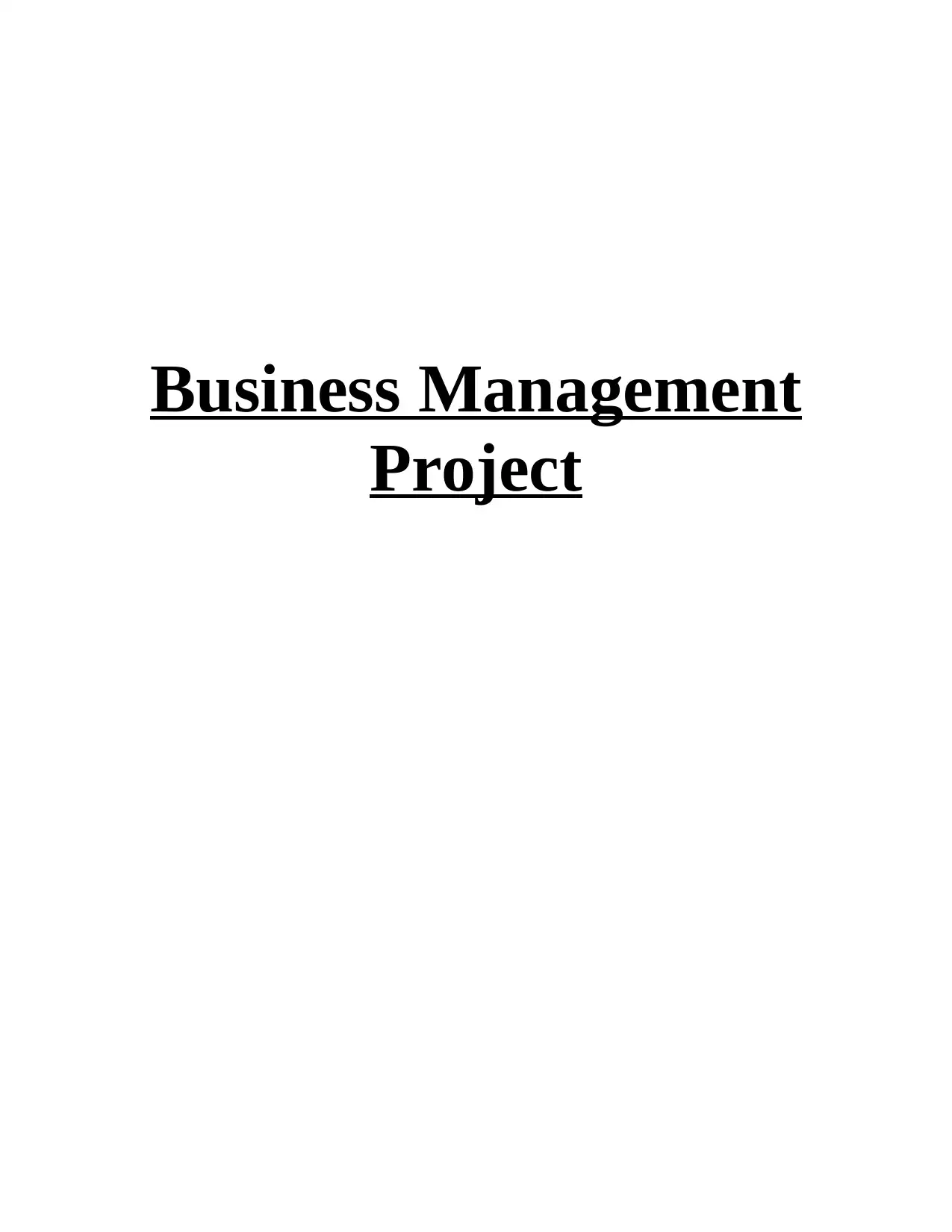
Business Management
Project
Project
Paraphrase This Document
Need a fresh take? Get an instant paraphrase of this document with our AI Paraphraser
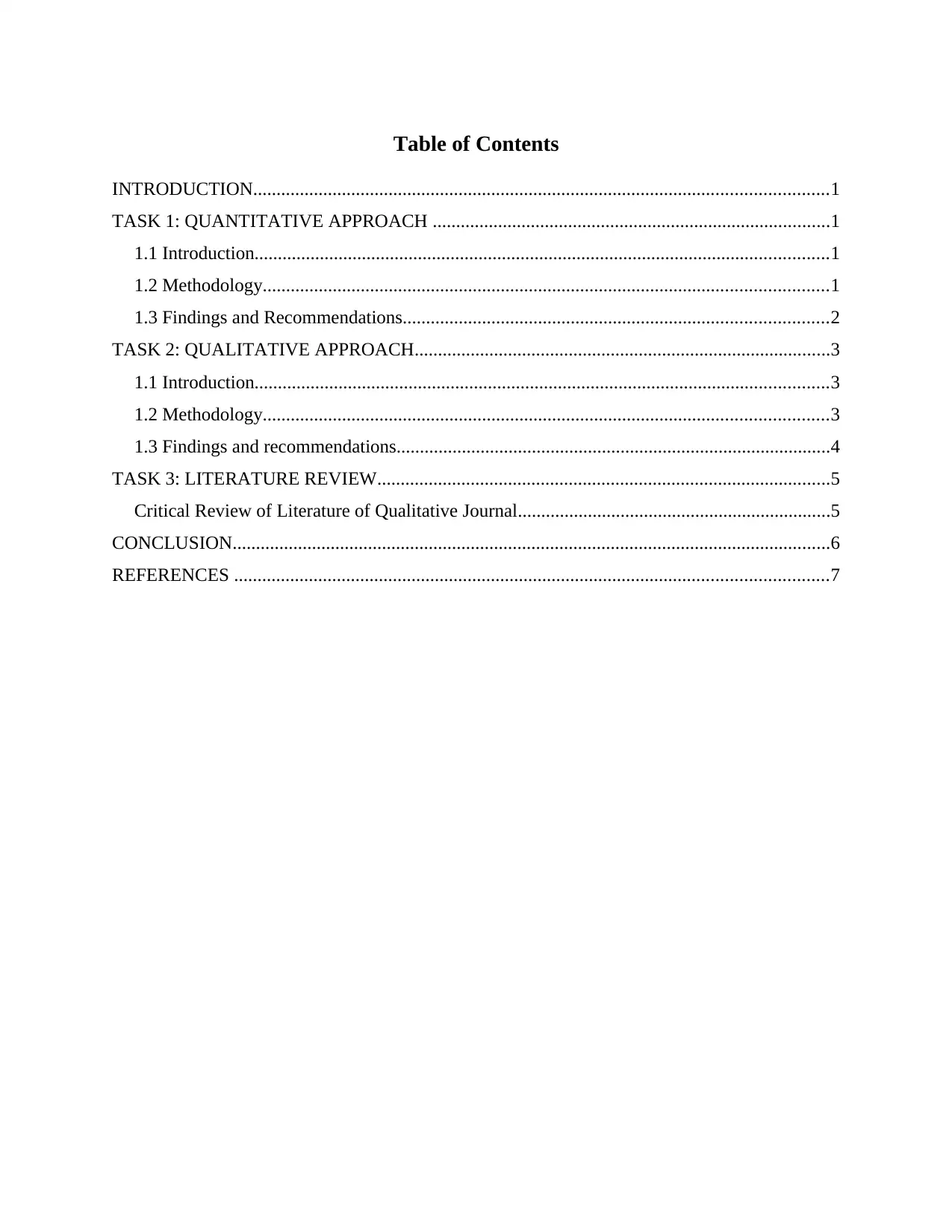
Table of Contents
INTRODUCTION...........................................................................................................................1
TASK 1: QUANTITATIVE APPROACH .....................................................................................1
1.1 Introduction...........................................................................................................................1
1.2 Methodology.........................................................................................................................1
1.3 Findings and Recommendations...........................................................................................2
TASK 2: QUALITATIVE APPROACH.........................................................................................3
1.1 Introduction...........................................................................................................................3
1.2 Methodology.........................................................................................................................3
1.3 Findings and recommendations.............................................................................................4
TASK 3: LITERATURE REVIEW.................................................................................................5
Critical Review of Literature of Qualitative Journal...................................................................5
CONCLUSION................................................................................................................................6
REFERENCES ...............................................................................................................................7
INTRODUCTION...........................................................................................................................1
TASK 1: QUANTITATIVE APPROACH .....................................................................................1
1.1 Introduction...........................................................................................................................1
1.2 Methodology.........................................................................................................................1
1.3 Findings and Recommendations...........................................................................................2
TASK 2: QUALITATIVE APPROACH.........................................................................................3
1.1 Introduction...........................................................................................................................3
1.2 Methodology.........................................................................................................................3
1.3 Findings and recommendations.............................................................................................4
TASK 3: LITERATURE REVIEW.................................................................................................5
Critical Review of Literature of Qualitative Journal...................................................................5
CONCLUSION................................................................................................................................6
REFERENCES ...............................................................................................................................7
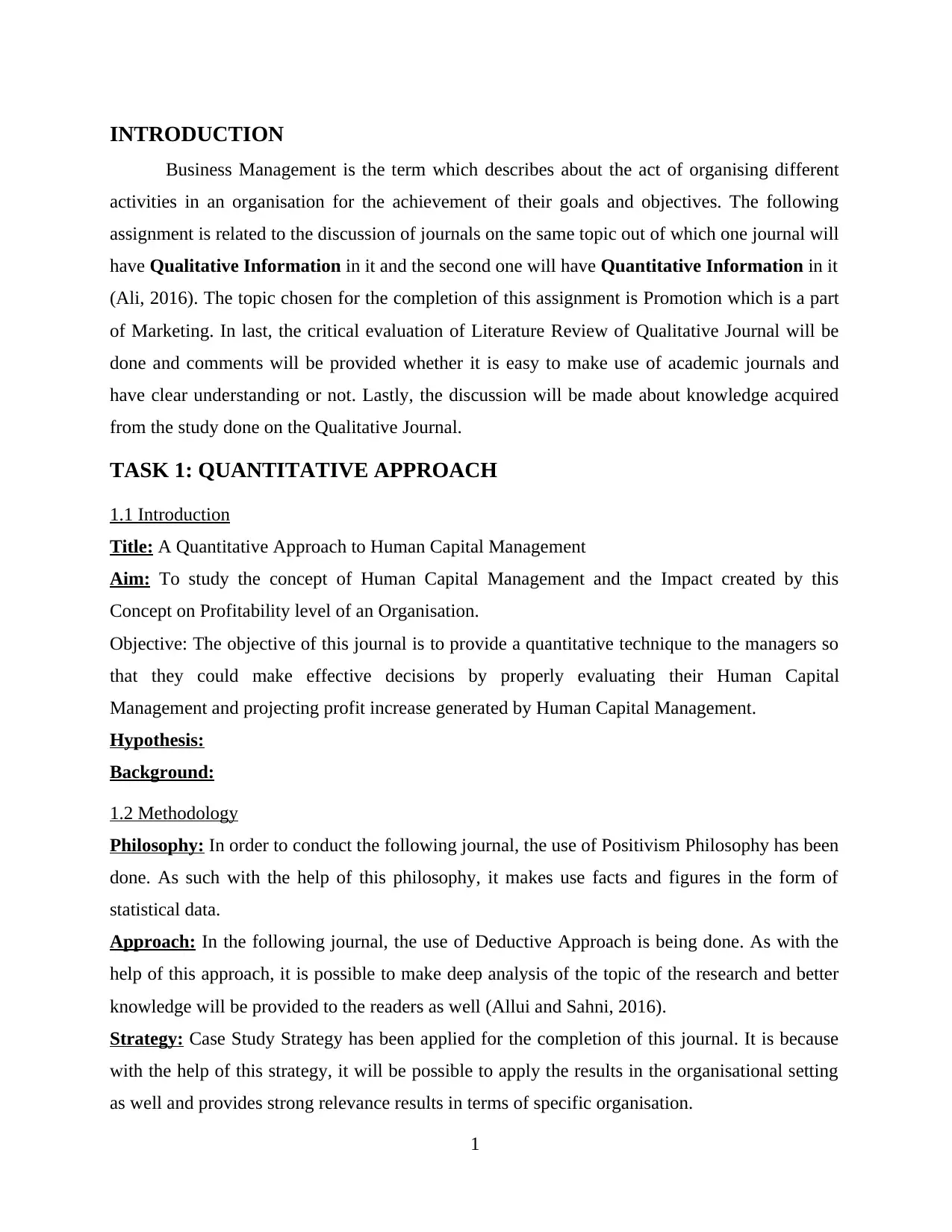
INTRODUCTION
Business Management is the term which describes about the act of organising different
activities in an organisation for the achievement of their goals and objectives. The following
assignment is related to the discussion of journals on the same topic out of which one journal will
have Qualitative Information in it and the second one will have Quantitative Information in it
(Ali, 2016). The topic chosen for the completion of this assignment is Promotion which is a part
of Marketing. In last, the critical evaluation of Literature Review of Qualitative Journal will be
done and comments will be provided whether it is easy to make use of academic journals and
have clear understanding or not. Lastly, the discussion will be made about knowledge acquired
from the study done on the Qualitative Journal.
TASK 1: QUANTITATIVE APPROACH
1.1 Introduction
Title: A Quantitative Approach to Human Capital Management
Aim: To study the concept of Human Capital Management and the Impact created by this
Concept on Profitability level of an Organisation.
Objective: The objective of this journal is to provide a quantitative technique to the managers so
that they could make effective decisions by properly evaluating their Human Capital
Management and projecting profit increase generated by Human Capital Management.
Hypothesis:
Background:
1.2 Methodology
Philosophy: In order to conduct the following journal, the use of Positivism Philosophy has been
done. As such with the help of this philosophy, it makes use facts and figures in the form of
statistical data.
Approach: In the following journal, the use of Deductive Approach is being done. As with the
help of this approach, it is possible to make deep analysis of the topic of the research and better
knowledge will be provided to the readers as well (Allui and Sahni, 2016).
Strategy: Case Study Strategy has been applied for the completion of this journal. It is because
with the help of this strategy, it will be possible to apply the results in the organisational setting
as well and provides strong relevance results in terms of specific organisation.
1
Business Management is the term which describes about the act of organising different
activities in an organisation for the achievement of their goals and objectives. The following
assignment is related to the discussion of journals on the same topic out of which one journal will
have Qualitative Information in it and the second one will have Quantitative Information in it
(Ali, 2016). The topic chosen for the completion of this assignment is Promotion which is a part
of Marketing. In last, the critical evaluation of Literature Review of Qualitative Journal will be
done and comments will be provided whether it is easy to make use of academic journals and
have clear understanding or not. Lastly, the discussion will be made about knowledge acquired
from the study done on the Qualitative Journal.
TASK 1: QUANTITATIVE APPROACH
1.1 Introduction
Title: A Quantitative Approach to Human Capital Management
Aim: To study the concept of Human Capital Management and the Impact created by this
Concept on Profitability level of an Organisation.
Objective: The objective of this journal is to provide a quantitative technique to the managers so
that they could make effective decisions by properly evaluating their Human Capital
Management and projecting profit increase generated by Human Capital Management.
Hypothesis:
Background:
1.2 Methodology
Philosophy: In order to conduct the following journal, the use of Positivism Philosophy has been
done. As such with the help of this philosophy, it makes use facts and figures in the form of
statistical data.
Approach: In the following journal, the use of Deductive Approach is being done. As with the
help of this approach, it is possible to make deep analysis of the topic of the research and better
knowledge will be provided to the readers as well (Allui and Sahni, 2016).
Strategy: Case Study Strategy has been applied for the completion of this journal. It is because
with the help of this strategy, it will be possible to apply the results in the organisational setting
as well and provides strong relevance results in terms of specific organisation.
1
⊘ This is a preview!⊘
Do you want full access?
Subscribe today to unlock all pages.

Trusted by 1+ million students worldwide
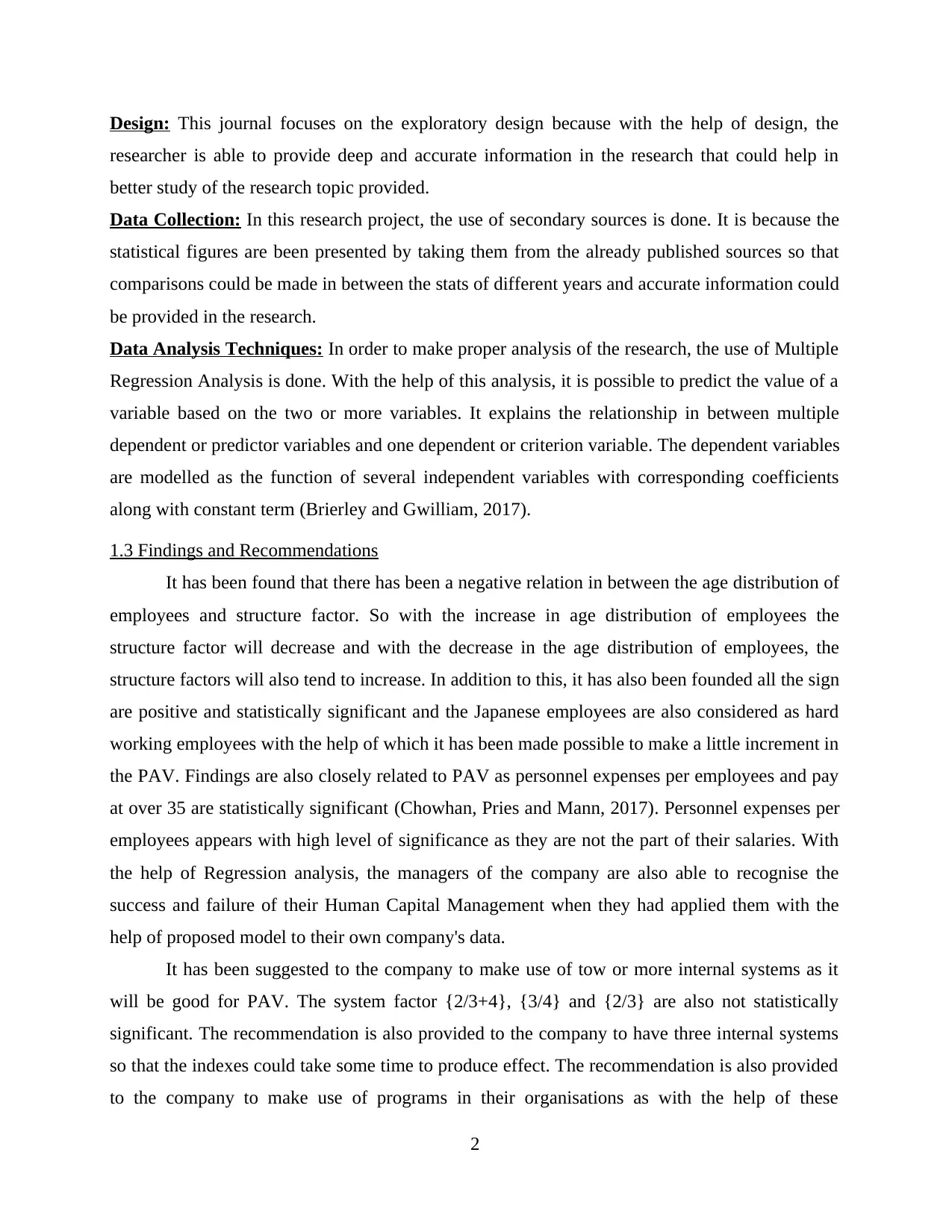
Design: This journal focuses on the exploratory design because with the help of design, the
researcher is able to provide deep and accurate information in the research that could help in
better study of the research topic provided.
Data Collection: In this research project, the use of secondary sources is done. It is because the
statistical figures are been presented by taking them from the already published sources so that
comparisons could be made in between the stats of different years and accurate information could
be provided in the research.
Data Analysis Techniques: In order to make proper analysis of the research, the use of Multiple
Regression Analysis is done. With the help of this analysis, it is possible to predict the value of a
variable based on the two or more variables. It explains the relationship in between multiple
dependent or predictor variables and one dependent or criterion variable. The dependent variables
are modelled as the function of several independent variables with corresponding coefficients
along with constant term (Brierley and Gwilliam, 2017).
1.3 Findings and Recommendations
It has been found that there has been a negative relation in between the age distribution of
employees and structure factor. So with the increase in age distribution of employees the
structure factor will decrease and with the decrease in the age distribution of employees, the
structure factors will also tend to increase. In addition to this, it has also been founded all the sign
are positive and statistically significant and the Japanese employees are also considered as hard
working employees with the help of which it has been made possible to make a little increment in
the PAV. Findings are also closely related to PAV as personnel expenses per employees and pay
at over 35 are statistically significant (Chowhan, Pries and Mann, 2017). Personnel expenses per
employees appears with high level of significance as they are not the part of their salaries. With
the help of Regression analysis, the managers of the company are also able to recognise the
success and failure of their Human Capital Management when they had applied them with the
help of proposed model to their own company's data.
It has been suggested to the company to make use of tow or more internal systems as it
will be good for PAV. The system factor {2/3+4}, {3/4} and {2/3} are also not statistically
significant. The recommendation is also provided to the company to have three internal systems
so that the indexes could take some time to produce effect. The recommendation is also provided
to the company to make use of programs in their organisations as with the help of these
2
researcher is able to provide deep and accurate information in the research that could help in
better study of the research topic provided.
Data Collection: In this research project, the use of secondary sources is done. It is because the
statistical figures are been presented by taking them from the already published sources so that
comparisons could be made in between the stats of different years and accurate information could
be provided in the research.
Data Analysis Techniques: In order to make proper analysis of the research, the use of Multiple
Regression Analysis is done. With the help of this analysis, it is possible to predict the value of a
variable based on the two or more variables. It explains the relationship in between multiple
dependent or predictor variables and one dependent or criterion variable. The dependent variables
are modelled as the function of several independent variables with corresponding coefficients
along with constant term (Brierley and Gwilliam, 2017).
1.3 Findings and Recommendations
It has been found that there has been a negative relation in between the age distribution of
employees and structure factor. So with the increase in age distribution of employees the
structure factor will decrease and with the decrease in the age distribution of employees, the
structure factors will also tend to increase. In addition to this, it has also been founded all the sign
are positive and statistically significant and the Japanese employees are also considered as hard
working employees with the help of which it has been made possible to make a little increment in
the PAV. Findings are also closely related to PAV as personnel expenses per employees and pay
at over 35 are statistically significant (Chowhan, Pries and Mann, 2017). Personnel expenses per
employees appears with high level of significance as they are not the part of their salaries. With
the help of Regression analysis, the managers of the company are also able to recognise the
success and failure of their Human Capital Management when they had applied them with the
help of proposed model to their own company's data.
It has been suggested to the company to make use of tow or more internal systems as it
will be good for PAV. The system factor {2/3+4}, {3/4} and {2/3} are also not statistically
significant. The recommendation is also provided to the company to have three internal systems
so that the indexes could take some time to produce effect. The recommendation is also provided
to the company to make use of programs in their organisations as with the help of these
2
Paraphrase This Document
Need a fresh take? Get an instant paraphrase of this document with our AI Paraphraser
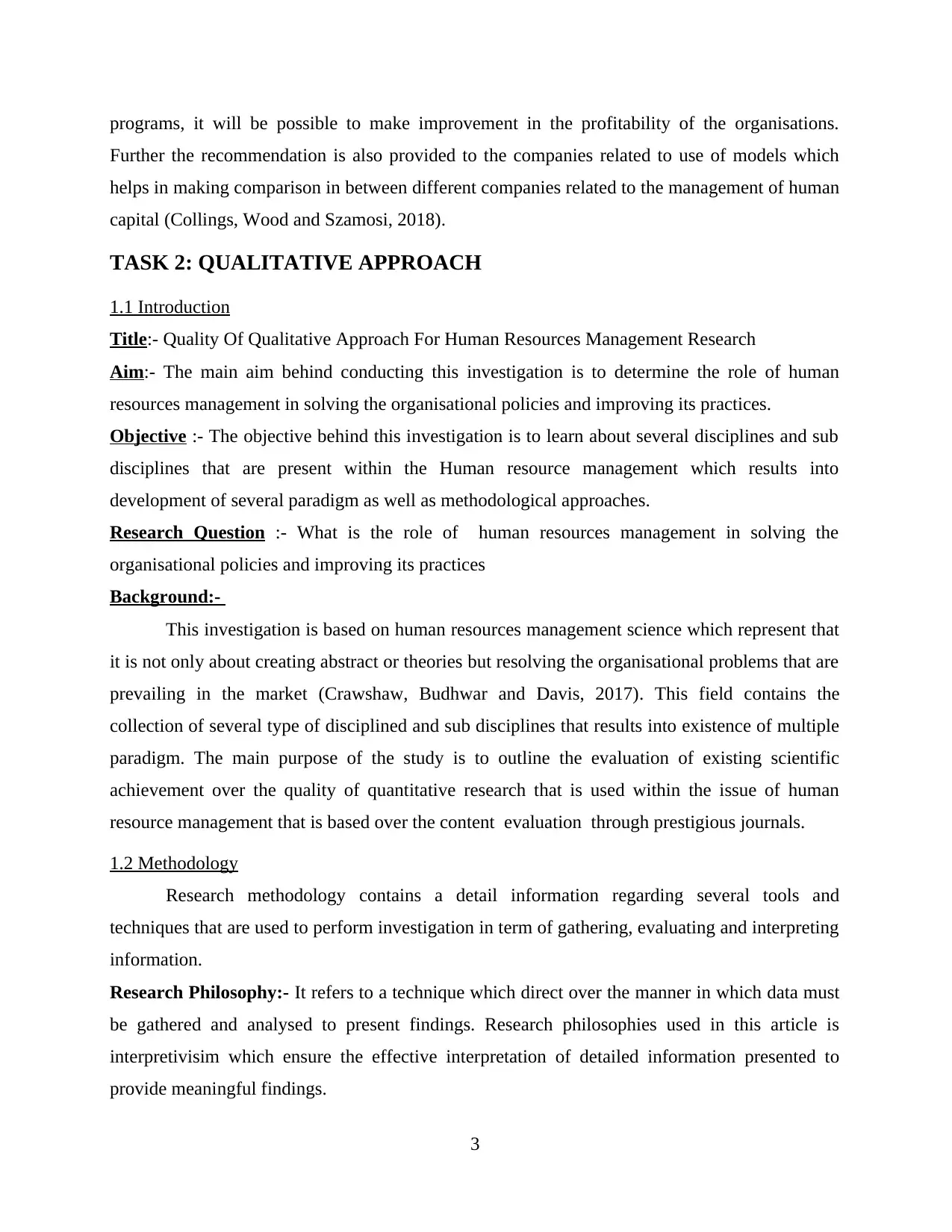
programs, it will be possible to make improvement in the profitability of the organisations.
Further the recommendation is also provided to the companies related to use of models which
helps in making comparison in between different companies related to the management of human
capital (Collings, Wood and Szamosi, 2018).
TASK 2: QUALITATIVE APPROACH
1.1 Introduction
Title:- Quality Of Qualitative Approach For Human Resources Management Research
Aim:- The main aim behind conducting this investigation is to determine the role of human
resources management in solving the organisational policies and improving its practices.
Objective :- The objective behind this investigation is to learn about several disciplines and sub
disciplines that are present within the Human resource management which results into
development of several paradigm as well as methodological approaches.
Research Question :- What is the role of human resources management in solving the
organisational policies and improving its practices
Background:-
This investigation is based on human resources management science which represent that
it is not only about creating abstract or theories but resolving the organisational problems that are
prevailing in the market (Crawshaw, Budhwar and Davis, 2017). This field contains the
collection of several type of disciplined and sub disciplines that results into existence of multiple
paradigm. The main purpose of the study is to outline the evaluation of existing scientific
achievement over the quality of quantitative research that is used within the issue of human
resource management that is based over the content evaluation through prestigious journals.
1.2 Methodology
Research methodology contains a detail information regarding several tools and
techniques that are used to perform investigation in term of gathering, evaluating and interpreting
information.
Research Philosophy:- It refers to a technique which direct over the manner in which data must
be gathered and analysed to present findings. Research philosophies used in this article is
interpretivisim which ensure the effective interpretation of detailed information presented to
provide meaningful findings.
3
Further the recommendation is also provided to the companies related to use of models which
helps in making comparison in between different companies related to the management of human
capital (Collings, Wood and Szamosi, 2018).
TASK 2: QUALITATIVE APPROACH
1.1 Introduction
Title:- Quality Of Qualitative Approach For Human Resources Management Research
Aim:- The main aim behind conducting this investigation is to determine the role of human
resources management in solving the organisational policies and improving its practices.
Objective :- The objective behind this investigation is to learn about several disciplines and sub
disciplines that are present within the Human resource management which results into
development of several paradigm as well as methodological approaches.
Research Question :- What is the role of human resources management in solving the
organisational policies and improving its practices
Background:-
This investigation is based on human resources management science which represent that
it is not only about creating abstract or theories but resolving the organisational problems that are
prevailing in the market (Crawshaw, Budhwar and Davis, 2017). This field contains the
collection of several type of disciplined and sub disciplines that results into existence of multiple
paradigm. The main purpose of the study is to outline the evaluation of existing scientific
achievement over the quality of quantitative research that is used within the issue of human
resource management that is based over the content evaluation through prestigious journals.
1.2 Methodology
Research methodology contains a detail information regarding several tools and
techniques that are used to perform investigation in term of gathering, evaluating and interpreting
information.
Research Philosophy:- It refers to a technique which direct over the manner in which data must
be gathered and analysed to present findings. Research philosophies used in this article is
interpretivisim which ensure the effective interpretation of detailed information presented to
provide meaningful findings.
3
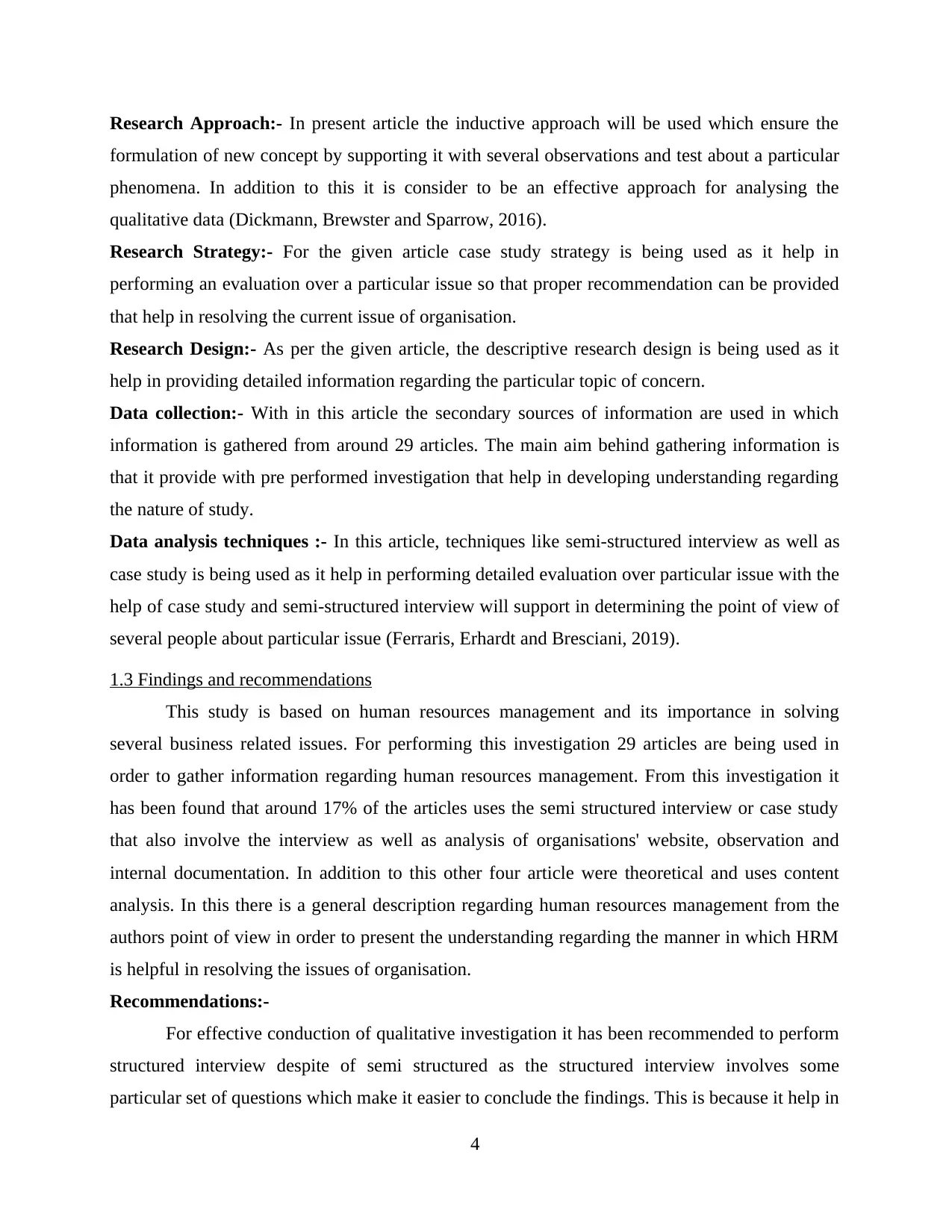
Research Approach:- In present article the inductive approach will be used which ensure the
formulation of new concept by supporting it with several observations and test about a particular
phenomena. In addition to this it is consider to be an effective approach for analysing the
qualitative data (Dickmann, Brewster and Sparrow, 2016).
Research Strategy:- For the given article case study strategy is being used as it help in
performing an evaluation over a particular issue so that proper recommendation can be provided
that help in resolving the current issue of organisation.
Research Design:- As per the given article, the descriptive research design is being used as it
help in providing detailed information regarding the particular topic of concern.
Data collection:- With in this article the secondary sources of information are used in which
information is gathered from around 29 articles. The main aim behind gathering information is
that it provide with pre performed investigation that help in developing understanding regarding
the nature of study.
Data analysis techniques :- In this article, techniques like semi-structured interview as well as
case study is being used as it help in performing detailed evaluation over particular issue with the
help of case study and semi-structured interview will support in determining the point of view of
several people about particular issue (Ferraris, Erhardt and Bresciani, 2019).
1.3 Findings and recommendations
This study is based on human resources management and its importance in solving
several business related issues. For performing this investigation 29 articles are being used in
order to gather information regarding human resources management. From this investigation it
has been found that around 17% of the articles uses the semi structured interview or case study
that also involve the interview as well as analysis of organisations' website, observation and
internal documentation. In addition to this other four article were theoretical and uses content
analysis. In this there is a general description regarding human resources management from the
authors point of view in order to present the understanding regarding the manner in which HRM
is helpful in resolving the issues of organisation.
Recommendations:-
For effective conduction of qualitative investigation it has been recommended to perform
structured interview despite of semi structured as the structured interview involves some
particular set of questions which make it easier to conclude the findings. This is because it help in
4
formulation of new concept by supporting it with several observations and test about a particular
phenomena. In addition to this it is consider to be an effective approach for analysing the
qualitative data (Dickmann, Brewster and Sparrow, 2016).
Research Strategy:- For the given article case study strategy is being used as it help in
performing an evaluation over a particular issue so that proper recommendation can be provided
that help in resolving the current issue of organisation.
Research Design:- As per the given article, the descriptive research design is being used as it
help in providing detailed information regarding the particular topic of concern.
Data collection:- With in this article the secondary sources of information are used in which
information is gathered from around 29 articles. The main aim behind gathering information is
that it provide with pre performed investigation that help in developing understanding regarding
the nature of study.
Data analysis techniques :- In this article, techniques like semi-structured interview as well as
case study is being used as it help in performing detailed evaluation over particular issue with the
help of case study and semi-structured interview will support in determining the point of view of
several people about particular issue (Ferraris, Erhardt and Bresciani, 2019).
1.3 Findings and recommendations
This study is based on human resources management and its importance in solving
several business related issues. For performing this investigation 29 articles are being used in
order to gather information regarding human resources management. From this investigation it
has been found that around 17% of the articles uses the semi structured interview or case study
that also involve the interview as well as analysis of organisations' website, observation and
internal documentation. In addition to this other four article were theoretical and uses content
analysis. In this there is a general description regarding human resources management from the
authors point of view in order to present the understanding regarding the manner in which HRM
is helpful in resolving the issues of organisation.
Recommendations:-
For effective conduction of qualitative investigation it has been recommended to perform
structured interview despite of semi structured as the structured interview involves some
particular set of questions which make it easier to conclude the findings. This is because it help in
4
⊘ This is a preview!⊘
Do you want full access?
Subscribe today to unlock all pages.

Trusted by 1+ million students worldwide
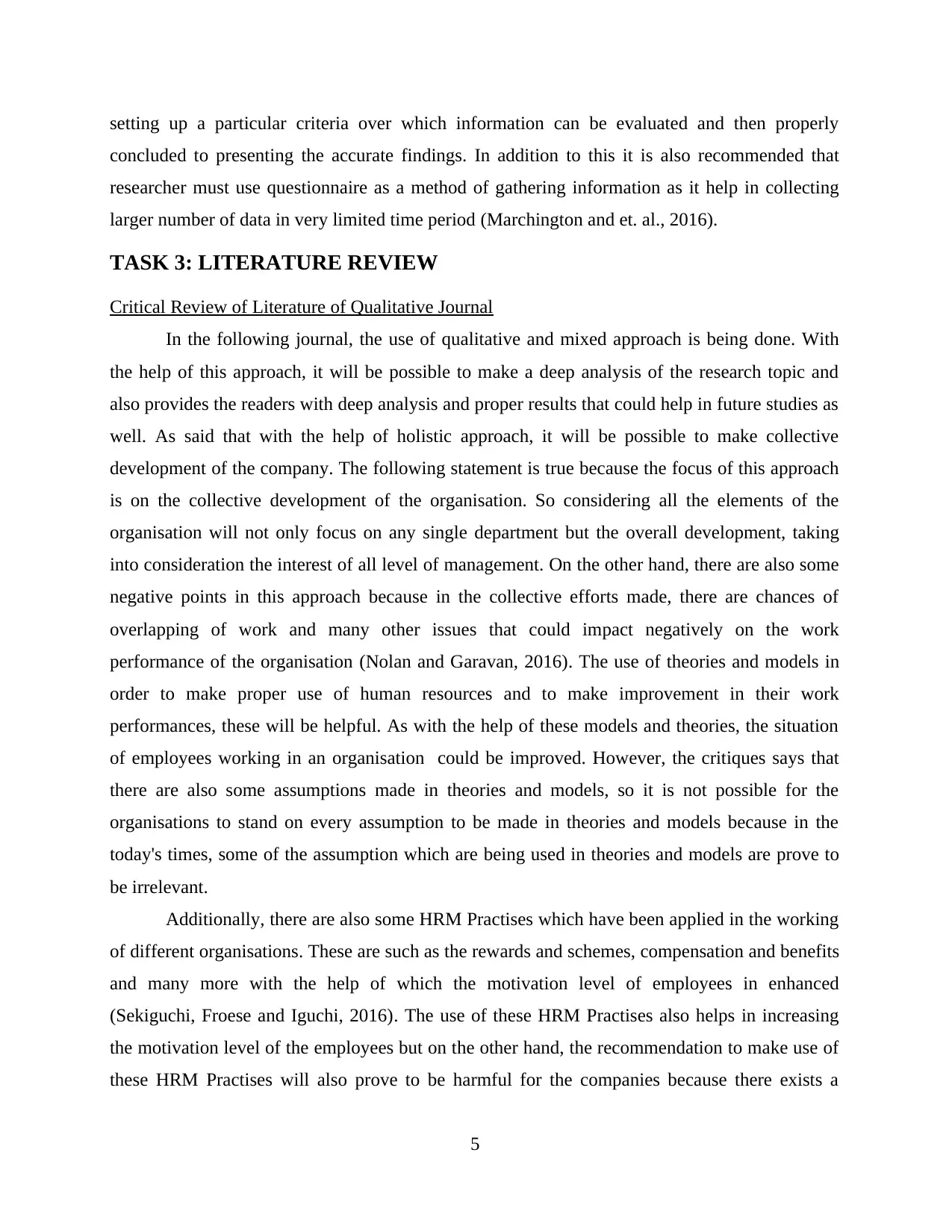
setting up a particular criteria over which information can be evaluated and then properly
concluded to presenting the accurate findings. In addition to this it is also recommended that
researcher must use questionnaire as a method of gathering information as it help in collecting
larger number of data in very limited time period (Marchington and et. al., 2016).
TASK 3: LITERATURE REVIEW
Critical Review of Literature of Qualitative Journal
In the following journal, the use of qualitative and mixed approach is being done. With
the help of this approach, it will be possible to make a deep analysis of the research topic and
also provides the readers with deep analysis and proper results that could help in future studies as
well. As said that with the help of holistic approach, it will be possible to make collective
development of the company. The following statement is true because the focus of this approach
is on the collective development of the organisation. So considering all the elements of the
organisation will not only focus on any single department but the overall development, taking
into consideration the interest of all level of management. On the other hand, there are also some
negative points in this approach because in the collective efforts made, there are chances of
overlapping of work and many other issues that could impact negatively on the work
performance of the organisation (Nolan and Garavan, 2016). The use of theories and models in
order to make proper use of human resources and to make improvement in their work
performances, these will be helpful. As with the help of these models and theories, the situation
of employees working in an organisation could be improved. However, the critiques says that
there are also some assumptions made in theories and models, so it is not possible for the
organisations to stand on every assumption to be made in theories and models because in the
today's times, some of the assumption which are being used in theories and models are prove to
be irrelevant.
Additionally, there are also some HRM Practises which have been applied in the working
of different organisations. These are such as the rewards and schemes, compensation and benefits
and many more with the help of which the motivation level of employees in enhanced
(Sekiguchi, Froese and Iguchi, 2016). The use of these HRM Practises also helps in increasing
the motivation level of the employees but on the other hand, the recommendation to make use of
these HRM Practises will also prove to be harmful for the companies because there exists a
5
concluded to presenting the accurate findings. In addition to this it is also recommended that
researcher must use questionnaire as a method of gathering information as it help in collecting
larger number of data in very limited time period (Marchington and et. al., 2016).
TASK 3: LITERATURE REVIEW
Critical Review of Literature of Qualitative Journal
In the following journal, the use of qualitative and mixed approach is being done. With
the help of this approach, it will be possible to make a deep analysis of the research topic and
also provides the readers with deep analysis and proper results that could help in future studies as
well. As said that with the help of holistic approach, it will be possible to make collective
development of the company. The following statement is true because the focus of this approach
is on the collective development of the organisation. So considering all the elements of the
organisation will not only focus on any single department but the overall development, taking
into consideration the interest of all level of management. On the other hand, there are also some
negative points in this approach because in the collective efforts made, there are chances of
overlapping of work and many other issues that could impact negatively on the work
performance of the organisation (Nolan and Garavan, 2016). The use of theories and models in
order to make proper use of human resources and to make improvement in their work
performances, these will be helpful. As with the help of these models and theories, the situation
of employees working in an organisation could be improved. However, the critiques says that
there are also some assumptions made in theories and models, so it is not possible for the
organisations to stand on every assumption to be made in theories and models because in the
today's times, some of the assumption which are being used in theories and models are prove to
be irrelevant.
Additionally, there are also some HRM Practises which have been applied in the working
of different organisations. These are such as the rewards and schemes, compensation and benefits
and many more with the help of which the motivation level of employees in enhanced
(Sekiguchi, Froese and Iguchi, 2016). The use of these HRM Practises also helps in increasing
the motivation level of the employees but on the other hand, the recommendation to make use of
these HRM Practises will also prove to be harmful for the companies because there exists a
5
Paraphrase This Document
Need a fresh take? Get an instant paraphrase of this document with our AI Paraphraser
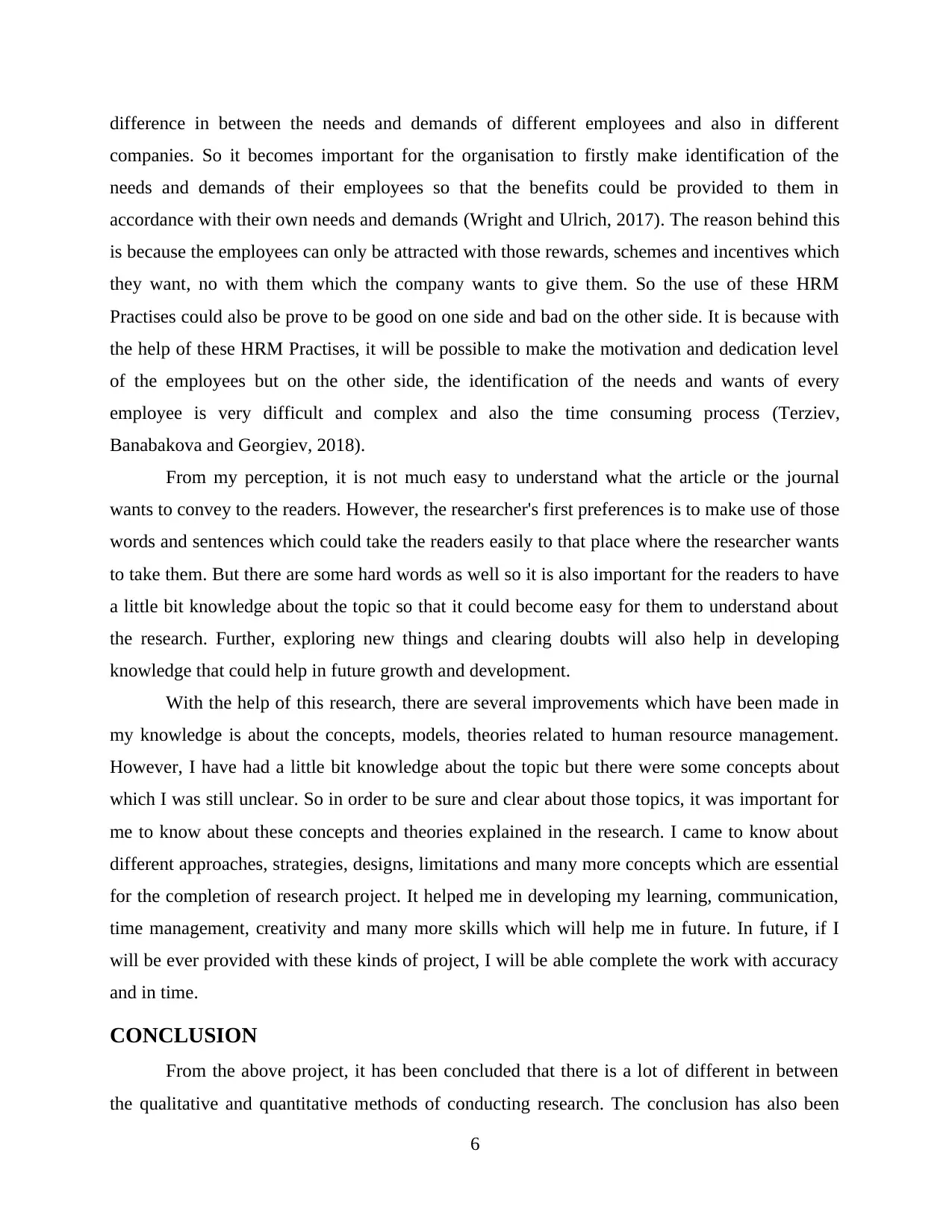
difference in between the needs and demands of different employees and also in different
companies. So it becomes important for the organisation to firstly make identification of the
needs and demands of their employees so that the benefits could be provided to them in
accordance with their own needs and demands (Wright and Ulrich, 2017). The reason behind this
is because the employees can only be attracted with those rewards, schemes and incentives which
they want, no with them which the company wants to give them. So the use of these HRM
Practises could also be prove to be good on one side and bad on the other side. It is because with
the help of these HRM Practises, it will be possible to make the motivation and dedication level
of the employees but on the other side, the identification of the needs and wants of every
employee is very difficult and complex and also the time consuming process (Terziev,
Banabakova and Georgiev, 2018).
From my perception, it is not much easy to understand what the article or the journal
wants to convey to the readers. However, the researcher's first preferences is to make use of those
words and sentences which could take the readers easily to that place where the researcher wants
to take them. But there are some hard words as well so it is also important for the readers to have
a little bit knowledge about the topic so that it could become easy for them to understand about
the research. Further, exploring new things and clearing doubts will also help in developing
knowledge that could help in future growth and development.
With the help of this research, there are several improvements which have been made in
my knowledge is about the concepts, models, theories related to human resource management.
However, I have had a little bit knowledge about the topic but there were some concepts about
which I was still unclear. So in order to be sure and clear about those topics, it was important for
me to know about these concepts and theories explained in the research. I came to know about
different approaches, strategies, designs, limitations and many more concepts which are essential
for the completion of research project. It helped me in developing my learning, communication,
time management, creativity and many more skills which will help me in future. In future, if I
will be ever provided with these kinds of project, I will be able complete the work with accuracy
and in time.
CONCLUSION
From the above project, it has been concluded that there is a lot of different in between
the qualitative and quantitative methods of conducting research. The conclusion has also been
6
companies. So it becomes important for the organisation to firstly make identification of the
needs and demands of their employees so that the benefits could be provided to them in
accordance with their own needs and demands (Wright and Ulrich, 2017). The reason behind this
is because the employees can only be attracted with those rewards, schemes and incentives which
they want, no with them which the company wants to give them. So the use of these HRM
Practises could also be prove to be good on one side and bad on the other side. It is because with
the help of these HRM Practises, it will be possible to make the motivation and dedication level
of the employees but on the other side, the identification of the needs and wants of every
employee is very difficult and complex and also the time consuming process (Terziev,
Banabakova and Georgiev, 2018).
From my perception, it is not much easy to understand what the article or the journal
wants to convey to the readers. However, the researcher's first preferences is to make use of those
words and sentences which could take the readers easily to that place where the researcher wants
to take them. But there are some hard words as well so it is also important for the readers to have
a little bit knowledge about the topic so that it could become easy for them to understand about
the research. Further, exploring new things and clearing doubts will also help in developing
knowledge that could help in future growth and development.
With the help of this research, there are several improvements which have been made in
my knowledge is about the concepts, models, theories related to human resource management.
However, I have had a little bit knowledge about the topic but there were some concepts about
which I was still unclear. So in order to be sure and clear about those topics, it was important for
me to know about these concepts and theories explained in the research. I came to know about
different approaches, strategies, designs, limitations and many more concepts which are essential
for the completion of research project. It helped me in developing my learning, communication,
time management, creativity and many more skills which will help me in future. In future, if I
will be ever provided with these kinds of project, I will be able complete the work with accuracy
and in time.
CONCLUSION
From the above project, it has been concluded that there is a lot of different in between
the qualitative and quantitative methods of conducting research. The conclusion has also been
6
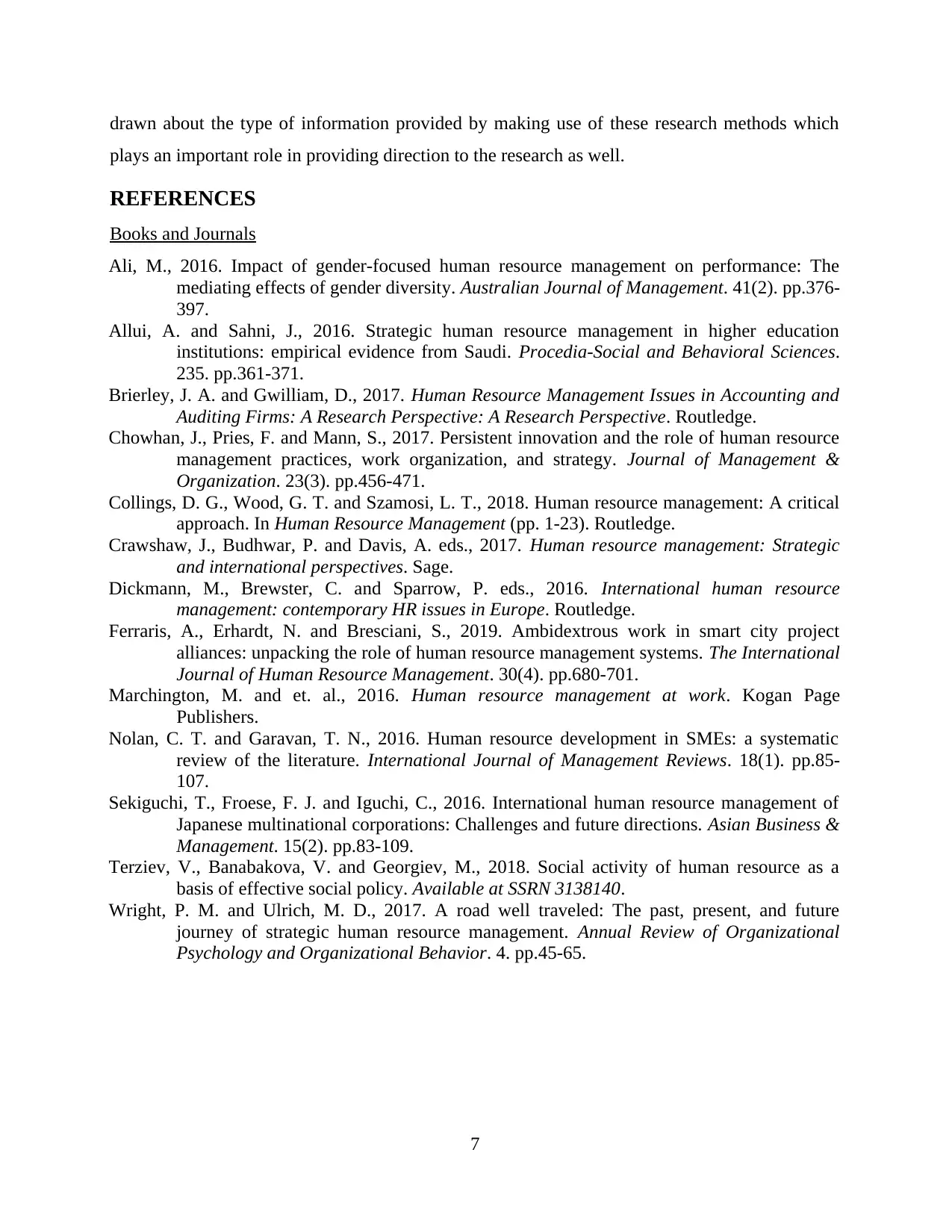
drawn about the type of information provided by making use of these research methods which
plays an important role in providing direction to the research as well.
REFERENCES
Books and Journals
Ali, M., 2016. Impact of gender-focused human resource management on performance: The
mediating effects of gender diversity. Australian Journal of Management. 41(2). pp.376-
397.
Allui, A. and Sahni, J., 2016. Strategic human resource management in higher education
institutions: empirical evidence from Saudi. Procedia-Social and Behavioral Sciences.
235. pp.361-371.
Brierley, J. A. and Gwilliam, D., 2017. Human Resource Management Issues in Accounting and
Auditing Firms: A Research Perspective: A Research Perspective. Routledge.
Chowhan, J., Pries, F. and Mann, S., 2017. Persistent innovation and the role of human resource
management practices, work organization, and strategy. Journal of Management &
Organization. 23(3). pp.456-471.
Collings, D. G., Wood, G. T. and Szamosi, L. T., 2018. Human resource management: A critical
approach. In Human Resource Management (pp. 1-23). Routledge.
Crawshaw, J., Budhwar, P. and Davis, A. eds., 2017. Human resource management: Strategic
and international perspectives. Sage.
Dickmann, M., Brewster, C. and Sparrow, P. eds., 2016. International human resource
management: contemporary HR issues in Europe. Routledge.
Ferraris, A., Erhardt, N. and Bresciani, S., 2019. Ambidextrous work in smart city project
alliances: unpacking the role of human resource management systems. The International
Journal of Human Resource Management. 30(4). pp.680-701.
Marchington, M. and et. al., 2016. Human resource management at work. Kogan Page
Publishers.
Nolan, C. T. and Garavan, T. N., 2016. Human resource development in SMEs: a systematic
review of the literature. International Journal of Management Reviews. 18(1). pp.85-
107.
Sekiguchi, T., Froese, F. J. and Iguchi, C., 2016. International human resource management of
Japanese multinational corporations: Challenges and future directions. Asian Business &
Management. 15(2). pp.83-109.
Terziev, V., Banabakova, V. and Georgiev, M., 2018. Social activity of human resource as a
basis of effective social policy. Available at SSRN 3138140.
Wright, P. M. and Ulrich, M. D., 2017. A road well traveled: The past, present, and future
journey of strategic human resource management. Annual Review of Organizational
Psychology and Organizational Behavior. 4. pp.45-65.
7
plays an important role in providing direction to the research as well.
REFERENCES
Books and Journals
Ali, M., 2016. Impact of gender-focused human resource management on performance: The
mediating effects of gender diversity. Australian Journal of Management. 41(2). pp.376-
397.
Allui, A. and Sahni, J., 2016. Strategic human resource management in higher education
institutions: empirical evidence from Saudi. Procedia-Social and Behavioral Sciences.
235. pp.361-371.
Brierley, J. A. and Gwilliam, D., 2017. Human Resource Management Issues in Accounting and
Auditing Firms: A Research Perspective: A Research Perspective. Routledge.
Chowhan, J., Pries, F. and Mann, S., 2017. Persistent innovation and the role of human resource
management practices, work organization, and strategy. Journal of Management &
Organization. 23(3). pp.456-471.
Collings, D. G., Wood, G. T. and Szamosi, L. T., 2018. Human resource management: A critical
approach. In Human Resource Management (pp. 1-23). Routledge.
Crawshaw, J., Budhwar, P. and Davis, A. eds., 2017. Human resource management: Strategic
and international perspectives. Sage.
Dickmann, M., Brewster, C. and Sparrow, P. eds., 2016. International human resource
management: contemporary HR issues in Europe. Routledge.
Ferraris, A., Erhardt, N. and Bresciani, S., 2019. Ambidextrous work in smart city project
alliances: unpacking the role of human resource management systems. The International
Journal of Human Resource Management. 30(4). pp.680-701.
Marchington, M. and et. al., 2016. Human resource management at work. Kogan Page
Publishers.
Nolan, C. T. and Garavan, T. N., 2016. Human resource development in SMEs: a systematic
review of the literature. International Journal of Management Reviews. 18(1). pp.85-
107.
Sekiguchi, T., Froese, F. J. and Iguchi, C., 2016. International human resource management of
Japanese multinational corporations: Challenges and future directions. Asian Business &
Management. 15(2). pp.83-109.
Terziev, V., Banabakova, V. and Georgiev, M., 2018. Social activity of human resource as a
basis of effective social policy. Available at SSRN 3138140.
Wright, P. M. and Ulrich, M. D., 2017. A road well traveled: The past, present, and future
journey of strategic human resource management. Annual Review of Organizational
Psychology and Organizational Behavior. 4. pp.45-65.
7
⊘ This is a preview!⊘
Do you want full access?
Subscribe today to unlock all pages.

Trusted by 1+ million students worldwide
1 out of 9
Related Documents
Your All-in-One AI-Powered Toolkit for Academic Success.
+13062052269
info@desklib.com
Available 24*7 on WhatsApp / Email
![[object Object]](/_next/static/media/star-bottom.7253800d.svg)
Unlock your academic potential
Copyright © 2020–2025 A2Z Services. All Rights Reserved. Developed and managed by ZUCOL.




